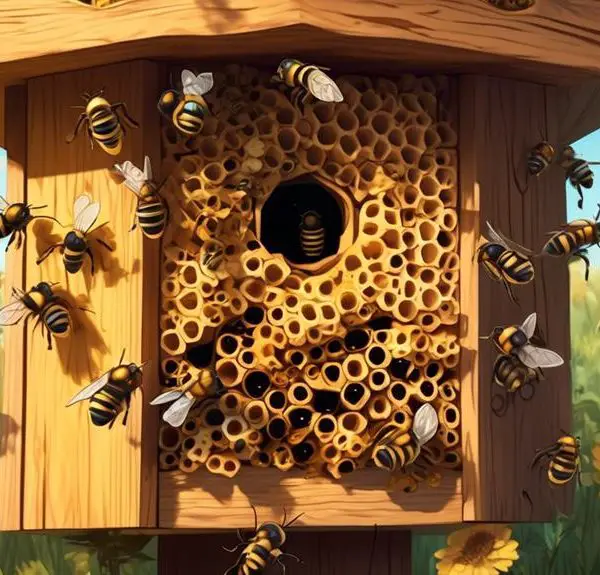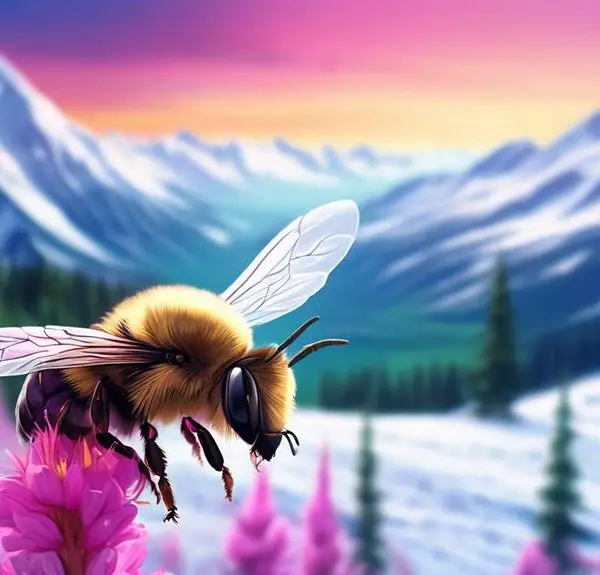Know the difference between Mason Bees and Mud Daubers? Discover the intriguing world of insect taxonomy and behavior.

Are Mason Bees the Same Species as Mud Daubers?
Just as you wouldn't mix up a Monarch butterfly with a common housefly, so too should we distinguish between Mason Bees and Mud Daubers.
You've likely seen them buzzing about, particularly in the summer months, but have you ever stopped to consider that these two insects might not be as similar as they appear?
Both are famous for their unique nesting habits, using mud to construct their homes, but does this common feature make them one and the same?
This seemingly simple question opens up a fascinating exploration into the world of insect taxonomy and behavior. Stick around, it's more riveting than it sounds.
Key Takeaways
- Mason bees and mud daubers are both solitary creatures, each building their own nests.
- Mason bees make their nests in hollow reeds or holes in wood, while mud daubers construct mud nests.
- Mason bees fill their nests with a mixture of pollen and nectar before laying an egg, while mud daubers store paralyzed spiders as food for their larvae.
- Mason bees are small, metallic blue or green in color, while mud daubers are larger with a slender, wasp-like body structure.
Understanding Mason Bees
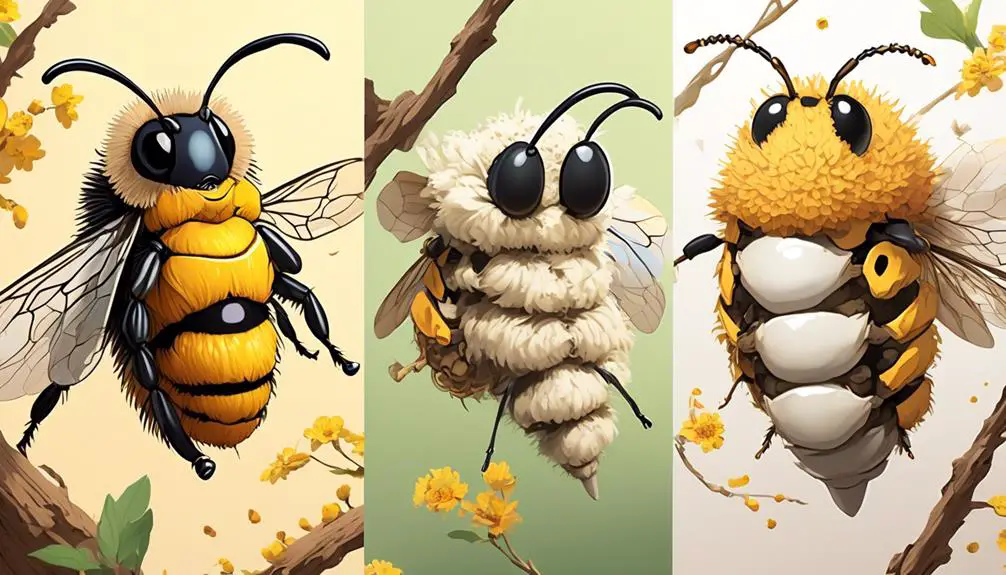
To truly appreciate the role of mason bees in our ecosystem, you must first understand their unique biology, behavior, and environmental preferences.
Unlike honeybees, mason bees are solitary creatures. Each female is fertile and makes her own nest, typically in hollow reeds or holes in wood, filling it with a mixture of pollen and nectar before laying an egg.
Physically, mason bees are small, about the size of a common house fly, and exhibit a metallic blue or green hue. Unlike honeybees, they don't produce honey or beeswax, nor do they live in colonies. They're known for their incredible pollinating abilities, often being more effective than honeybees.
As for their environmental preferences, mason bees prefer a habitat with plenty of flowering plants for nectar and pollen collection. They're also attracted to areas with available nesting sites like hollow stems or man-made bee houses.
Understanding these aspects of their biology and behavior, you'll realize why mason bees are invaluable. They're not just crucial for our gardens, but for our entire ecosystem, contributing significantly to plant reproduction and biodiversity.
Insight Into Mud Daubers
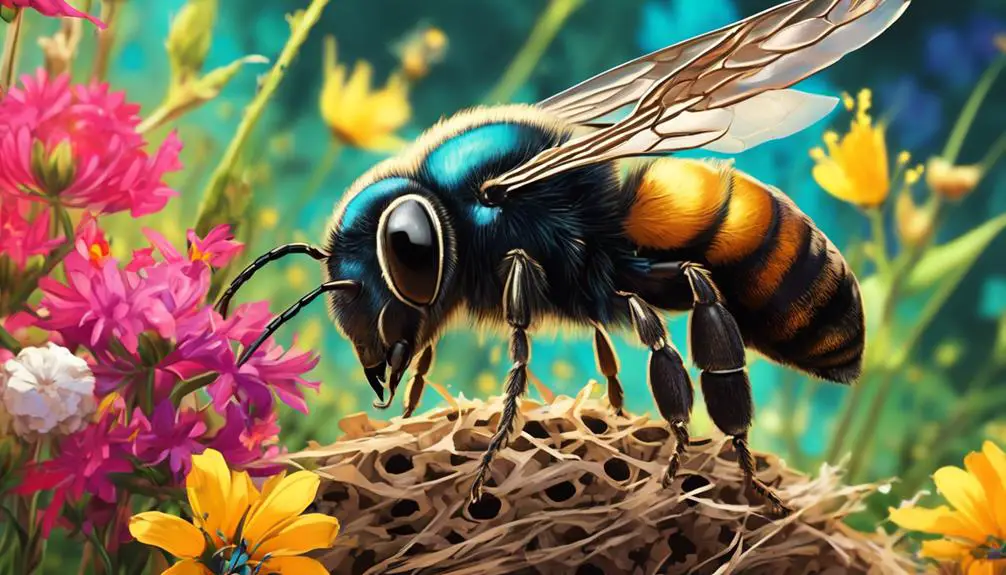
While you've gained a good grasp of mason bees, it's equally essential to understand mud daubers, another fascinating species with their own unique attributes and behaviors.
Mud daubers are a type of wasp, known for their cylindrical mud nests. Yet, unlike many of their wasp relatives, mud daubers are solitary creatures, each female building her own nest.
You should know that mud daubers aren't aggressive. They rarely sting unless threatened or handled roughly. Their slender, thread-like waist distinguishes them from other wasps. The nests they construct are used for their offspring. Inside the nest, you'll find paralyzed spiders, the future food for the wasp's larvae.
The most common types of mud daubers are the black and yellow mud dauber, the organ pipe mud dauber, and the blue mud dauber. Each type has its own unique nesting habits and life cycle. For instance, the organ pipe mud dauber builds its nests in the shape of long, cylindrical tubes resembling organ pipes, hence the name.
Comparing Physical Characteristics

In comparing the physical characteristics of mason bees and mud daubers, you'll notice a distinct difference in their size, shape, and coloration, each perfectly adapted to their unique lifestyles and environments.
Mason bees are typically small, only about 10 millimeters in length, with a robust and cylindrical shape. They possess a stunning metallic blue or green sheen, a trait that's not found in many other bee species.
On the other hand, mud daubers are considerably larger, often reaching up to 25 millimeters in length. They've a slender, elongated body structure, more reminiscent of a wasp than a bee. Their coloration varies from black to metallic blue, sometimes with yellow or green markings, depending on the species.
One key distinctive feature of mud daubers is their 'thread-waisted' body, with a noticeably thin segment connecting the thorax and abdomen. This is in stark contrast to the compact, stout body of the mason bee.
Both mason bees and mud daubers have wings, yet their wing structures and flight patterns differ significantly. Mason bees have darker, more opaque wings and are known for their swift, direct flight.
Meanwhile, mud daubers have clear, membranous wings and exhibit a more hovering style of flight.
Behavioral Differences and Similarities
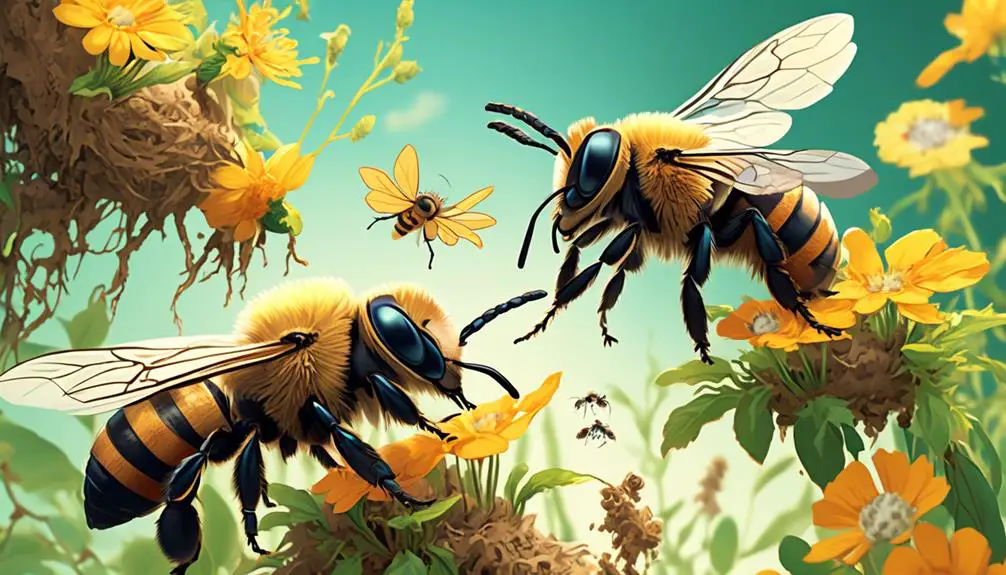
Shifting focus from physical attributes, let's now examine how mason bees and mud daubers differ and coincide in their behaviors. Both insects are solitary, meaning they don't live in hives or colonies like honeybees or wasps. Yet, their nesting habits are remarkably different.
Mason bees look for pre-existing cavities or holes to lay their eggs, while mud daubers construct their own nests using mud. When it comes to feeding, mason bees are mainly pollen and nectar feeders. Mud daubers, however, feed on spiders, which they paralyze and store in their mud nests for their larvae to eat.
Here's a quick comparison table:
Behavior | Mason Bees | Mud Daubers |
|---|---|---|
Nesting | Utilize pre-existing holes or cavities | Build nests with mud |
Feeding | Feed on pollen and nectar | Paralyze and store spiders for larvae |
Sociality | Solitary | Solitary |
It's crucial to understand these behavioral aspects as they directly impact their interaction with humans and the environment. Remember, neither species is typically aggressive towards humans, but their presence can still warrant concern depending on the circumstances.
Impact on the Ecosystem

Despite their solitary nature, both mason bees and mud daubers play significant roles in the ecosystem, contributing to plant pollination and natural pest control, respectively.
Mason bees, while not as recognized as honey bees, are superb pollinators. They're known to carry pollen on their abdomen, transferring it between flowers more effectively. Their work is integral to the survival and propagation of various plant species, especially fruit trees.
On the other hand, mud daubers, a type of wasp, are natural pest controllers. They feed on spiders, reducing their populations. This is particularly beneficial in areas where spider populations are high or where certain spiders pose risks to humans.
Furthermore, both species provide food for predators, contributing to the food chain. Birds, bats, and certain insects prey on them, maintaining an ecological balance.
In essence, both mason bees and mud daubers are vital in maintaining the ecosystem's health. They each perform specific roles that impact the environment positively. While they may seem insignificant due to their solitary lifestyles, they are, in fact, important cogs in the wheel of nature.
Understanding their roles can help us appreciate their presence and protect their habitats.
Conclusion
In conclusion, you've seen that Mason bees and Mud daubers aren't the same species. They differ in physical characteristics and behaviors.
Mason bees are important pollinators while Mud daubers help in pest control. Both play vital roles in our ecosystem.
By understanding their differences, you can better appreciate these intriguing insects and their unique contributions to our natural world.

